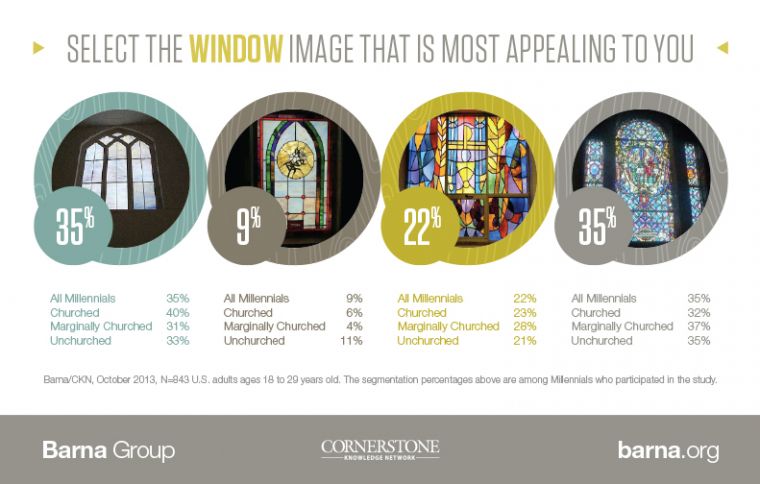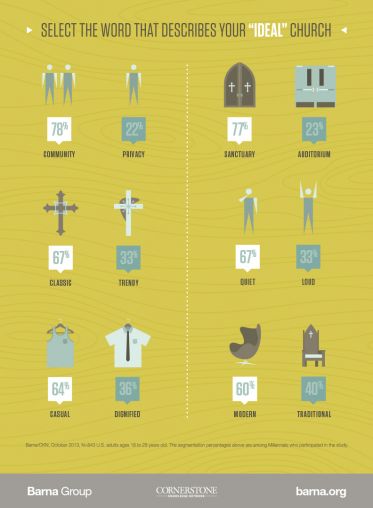Which kind of church appeals to Millennials? It's not as trendy and modern as you think

They're the designer coffee, social media immersed generation and you could be forgiven for thinking the ideal church of Millennials would look something like a darkened auditorium fronted by a stage and multimedia screen rather than an old wooden altar with stained glass and religious decorations.
However, new research by the Barna group paints a far more complex picture of the tastes of Millennials when it comes to the style of churches they find appealing.
The last two decades have seen many churches in the Western world undergo some major redecorating, doing away with the old pews and vestments, and replacing the organs with trendy worship bands.
Even when it comes to the building type, new congregations today will often be found gathering together in minimalist auditoriums, theatres or community halls, rather than ornate stone churches with spires and stained glass.
These choices are likely to reflect assumptions about the kind of church that will have the most appeal to the people they want to become part of the community of God.
With Millennials often dubbed the "missing generation" in today's church, the obvious question for many congregations is how to appeal to them.
Barna's research, in partnership with Cornerstone Knowledge Network, sought to answer this question by carrying out some visual polling that asked 18 to 29-year-olds to respond to sets of images related to church.
The first set showed images of four different kinds of worship spaces and asked respondents to identify the one they found the most appealing.

The clear favourite (44%) was Sanctuary 2, a medium-sized auditorium with a stage at the front and intimate lighting scheme.
The two that resonated the least were the sprawling super-sized auditorium and a small auditorium that was devoid of any Christian symbols.
Barna speculated that Sanctuary 2 had the greatest appeal because it was the perfect balance of "not too big, not too small".
"Just right. It's big enough to retain some anonymity as a visitor – the marginally churched (63%) and those who are not practicing Christians (50%) preferred it more strongly than the average – but small enough to feel part of a community," it said.
The study also found that Sanctuary 2 was the most popular among parents with children under the age of 18.
Interestingly, Barna found a degree of "tacit distrust" towards very large churches, with one respondent summing it up: "It seems like a really big business."
The second set of images asked participants to choose their preferred altar, ranging from plain to traditional and ornate.
Interestingly the most appealing altar (37%) was much more traditional in appearance than the others, combining a large crucifix, candles and stained glass windows, which was much more popular than a simple, undecorated altar (19%).
"These patterns illustrate most Millennials' overall preference for a straightforward, overtly Christian style of imagery—as long as it doesn't look too institutional or corporate. Not only do such settings physically direct one's attention to the divine, they also provide a rich context of church history as the backdrop for worship," said Barna.

Another set of images gauged responses to windows that ranged from plain glass to highly stylised stained glass.
Opinion was split, with the same number (35%) favouring the plain glass window and the very detailed stained glass.
The obvious conclusion? "Millennials like both!" said Barna.
The research group noted one field test in which participants were taken to Church of the Redeemer in Atlanta, Georgia, a church with both ornate staind glass and plain windows.
"It has a small prayer chapel with an ornate stained glass image of Jesus at the front, flanked by two large, open windows. The overall effect is pleasing, and was noticed with appreciation by field participants," the study read.

In another test, participants were asked to choose between contrasting words to describe their vision of the ideal church.
In 'Classic' vs 'Trendy', classic surprisingly won the day with 67% of the vote compared to 33%.
They were also more likely to choose 'Sanctuary' (77%) over 'Auditorium' (23%) and 'Quiet' (67%) over 'Loud' (33%) worship.

However, they were more likely to favour 'Casual' (64%) over 'Dignified' (36%) when it came to attire, and 'Modern' (60%) over 'Traditional' (40%) in relation to church furnishings.
Vice president of research at Barna Group Clint Jenkin said there are some questions churches should keep in mind as they think through their space, like whether people can find peace and get a sense of the sacred.
"It's tempting to oversimplify the relationship between Millennials and sacred space," said Jenkin.
"For instance, it might be easy to believe such a place needs to look ultra modern or chic to appeal to teens and young adults. But the reality, like so much about this generation, is more complicated—refreshingly so.
"Most Millennials don't look for a church facility that caters to the whims of pop culture. They want a community that calls them to deeper meaning.
"There are myriad ways to design sacred and communal spaces that call people of all ages to deeper relationships with God, self and others.
"No two churches will (or should) incorporate them all in the same way. There is no cookie-cutter, mass-production solution for welcoming Millennials to your space."
See the Barna study in full here











